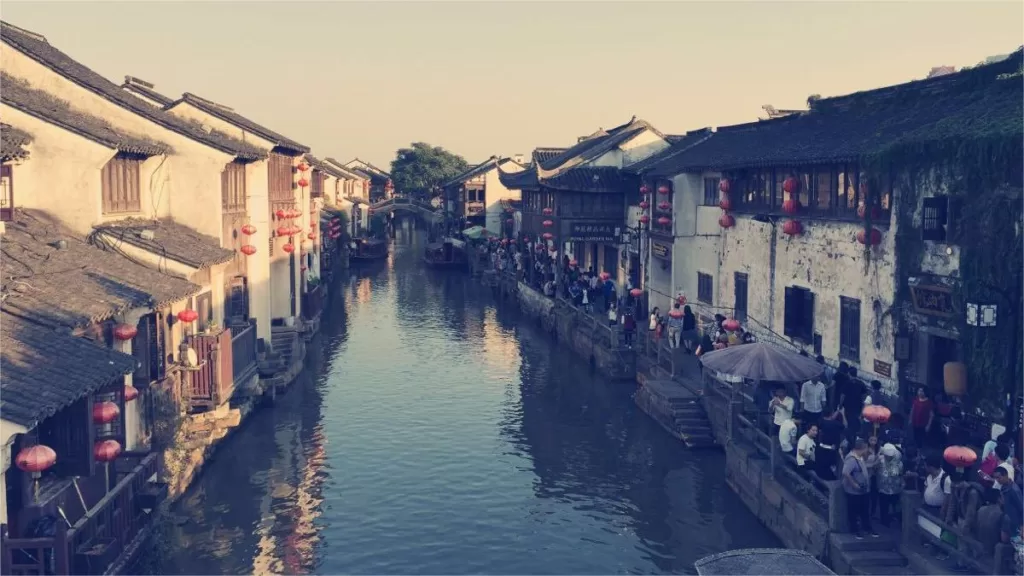Shantang-Kanal, Suzhou - ein zeitloses Erbe der alten Wasserstraßen


Nestled in the eastern part of China, amidst the captivating city of Suzhou, lies a gem of ancient engineering and cultural heritage known as the Shantang Canal. Carrying a rich history dating back over two millennia, this remarkable waterway has stood the test of time, preserving the traditions, stories, and spirit of its people. The Shantang Canal is not only a testament to human ingenuity but also an embodiment of the profound beauty and elegance that define Suzhou’s allure.
The origins of the Shantang Canal can be traced back to the Spring and Autumn period (770-476 BCE), making it one of the oldest man-made canals in the world. Constructed during the Wu Kingdom, it was initially intended as a means of water transport and trade between the prosperous Yangtze River Delta and the neighboring regions. Over the centuries, the canal evolved into a vital artery of Suzhou’s economic growth and cultural exchange, leaving behind a tapestry of stories woven into its stone banks.
Stretching for approximately seven kilometers, the Shantang Canal offers an immersive journey through time. Its picturesque scenery is dotted with historic architecture, traditional houses, and elegant stone bridges, all of which provide a window into the past. One of the most endearing features of the canal is the Ming and Qing Dynasty style residences that line its banks, with whitewashed walls and black-tiled roofs harmoniously blending with the natural surroundings.
Walking along the canal’s edge, visitors are greeted with the sights and sounds of everyday life unfolding on the water. Dragon-headed boats leisurely glide across the surface, ferrying curious travelers who wish to experience the old-world charm of the canal up close. The reflections of ancient buildings shimmer in the water, creating a dreamlike ambiance that captivates the heart and mind.
Beyond its aesthetic appeal, the Shantang Canal holds profound cultural significance. The canal has inspired generations of poets, scholars, and artists, who sought inspiration from its tranquil beauty. The likes of Bai Juyi, Su Dongpo, and countless others penned verses extolling the charm of this remarkable waterway. The canal’s allure even extended to painters, who immortalized its scenery on silk scrolls, preserving its essence for posterity.
The canal’s influence on local life is also evident in the traditional customs and festivals celebrated along its shores. The annual Shantang Lantern Festival is a spectacle of lights and colors that attracts visitors from far and wide. During this event, the canal becomes a living canvas, adorned with hundreds of glowing lanterns, each carrying a wish for happiness and prosperity.
Moreover, the Shantang Canal has served as a cultural crossroads, facilitating the exchange of ideas and traditions between East and West. As an integral part of the Grand Canal system, it played a vital role in connecting Suzhou with other major cities, fostering trade, and enriching the region’s cultural diversity. Along its banks, one can still find traces of foreign influences, testament to Suzhou’s historical openness and cosmopolitan spirit.
Preserving and restoring the Shantang Canal has been an ongoing endeavor, with concerted efforts to retain its historical authenticity and charm. Local authorities and conservationists have worked tirelessly to safeguard this invaluable heritage for future generations to appreciate and cherish.
In conclusion, the Shantang Canal in Suzhou stands as an enduring testament to the ingenuity and creativity of ancient civilizations. Its tranquil waters carry the echoes of the past, whispering tales of prosperity, culture, and human endeavor. As visitors wander along its banks, they are transported to a world that is both ancient and timeless, a world that embodies the essence of Suzhou’s allure – a harmonious blend of nature, culture, and human spirit. The Shantang Canal remains an exquisite embodiment of China’s profound history and its unyielding connection to its cultural roots.
Fakten zu historischen Stätten in Jiangsu